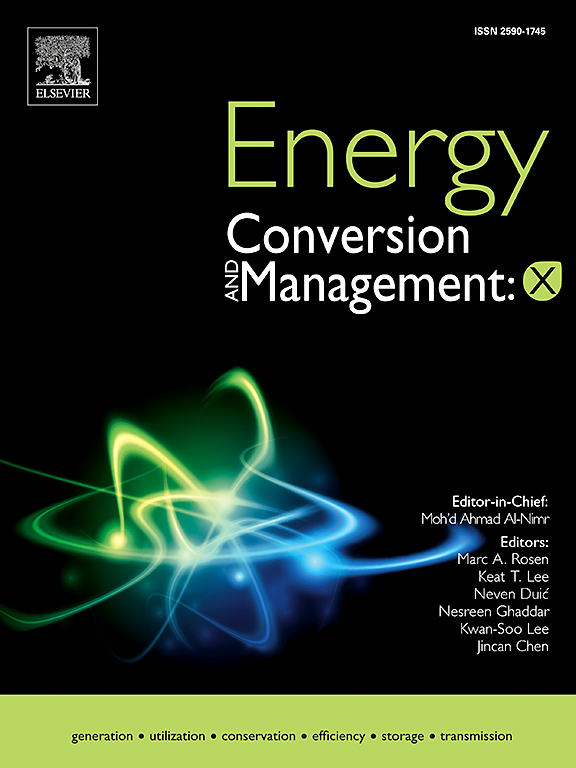利用稻壳燃料混流式干燥机进行稻米干燥动力学建模、性能评估和经济分析
IF 7.1
Q1 ENERGY & FUELS
引用次数: 0
摘要
本研究调查了本地制造的稻壳燃料混流式稻米干燥机的性能评估、干燥动力学建模和经济分析。烘干机的尺寸为 0.4 × 0.4 × 0.64 米(宽、长、高),批次容纳量为 30 公斤。所用干燥空气的体积流量为 0.06 立方米/秒,干燥段内的平均干燥风速为 0.62 米/秒。实验期间记录到的干燥机入口平均温度为 49.5 ± 3.1℃,而环境空气温度为 26.4 ± 0.2℃。干燥机能在 3 小时 10 分钟内将样品大米的含水量从 20.9%(湿基)降至 12%(湿基),平均干燥速率为每分钟 0.076 千克水或每千克干物质 0.016 千克水。为了达到这一干燥率,平均能耗为 37.9 兆焦耳,平均干燥效率为 54.29%。在本研究中,在不同的薄层干燥模型中,改良亨德森& 帕比斯是预测干燥动力学的最佳干燥模型。使用头米产量(HRY)评估了干燥产品的碾磨质量。结果发现,细长型 Nerica-4 稻米品种的头米产量为 57.4 ± 0.62%,高于客户要求的 55%及以上。此外,经济分析表明,开发的稻壳燃料混流式干燥机用于干燥稻米的投资回收期为 1.4 年。这种烘干机的成本为 64 213ETB (约合 1 230 美元),有可能显著减少收获后的损失,提高农村离网地区小农的粮食安全和收入。本文章由计算机程序翻译,如有差异,请以英文原文为准。
Modeling the drying kinetics, performance evaluation, and economic analysis of rice drying using a rice husk-fueled mixed-flow dryer
In this study, performance evaluation, drying kinetics modelling and economic analysis of locally manufactured rice husk-fueled mixed-flow rice dryer were investigated. The dryer had a size of 0.4 × 0.4 × 0.64 m (width, length, and height) with a holding capacity of 30 kg in a batch. The drying air used had a volume flow rate of 0.06 m3/s, with an average drying air velocity of 0.62 m/s within the drying section. The average temperature recorded during the experiment was 49.5 ± 3.1℃ at the dryer inlet, while the ambient air temperature was 26.4 ± 0.2℃. The dryer was able to reduce the moisture content of the sample rice from 20.9 % (wet bases) to 12 % (wet bases) in 3 h and 10 min, achieving an average drying rate of 0.076 kg water per minute or 0.016 kg water per kg dry matter per minute. In order to achieve this drying rate, the average energy consumption was 37.9 MJ with an average of 54.29 % dryer efficiency. The Modified Henderson & Pabis was the best drying model to predict the drying kinetics in this study among the different thin-layer drying models. The milling quality of the dry product was assessed using the Head Rice Yield (HRY). The HRY was found to be 57.4 ± 0.62 % for long and slender Nerica-4 rice cultivars, the result was above the required customer requirement which is 55 % and more. Furthermore, the economic analysis indicated that the payback period for the developed rice husk-fueled mixed-flow dryer for drying rice was 1.4 years. The dryer, which costs 64,213ETB (approximately USD 1,230) has the potential to significantly reduce postharvest loss and enhance food security and income of smallholder farmers in rural off-grid areas.
求助全文
通过发布文献求助,成功后即可免费获取论文全文。
去求助
来源期刊

Energy Conversion and Management-X
Multiple-
CiteScore
8.80
自引率
3.20%
发文量
180
审稿时长
58 days
期刊介绍:
Energy Conversion and Management: X is the open access extension of the reputable journal Energy Conversion and Management, serving as a platform for interdisciplinary research on a wide array of critical energy subjects. The journal is dedicated to publishing original contributions and in-depth technical review articles that present groundbreaking research on topics spanning energy generation, utilization, conversion, storage, transmission, conservation, management, and sustainability.
The scope of Energy Conversion and Management: X encompasses various forms of energy, including mechanical, thermal, nuclear, chemical, electromagnetic, magnetic, and electric energy. It addresses all known energy resources, highlighting both conventional sources like fossil fuels and nuclear power, as well as renewable resources such as solar, biomass, hydro, wind, geothermal, and ocean energy.
 求助内容:
求助内容: 应助结果提醒方式:
应助结果提醒方式:


